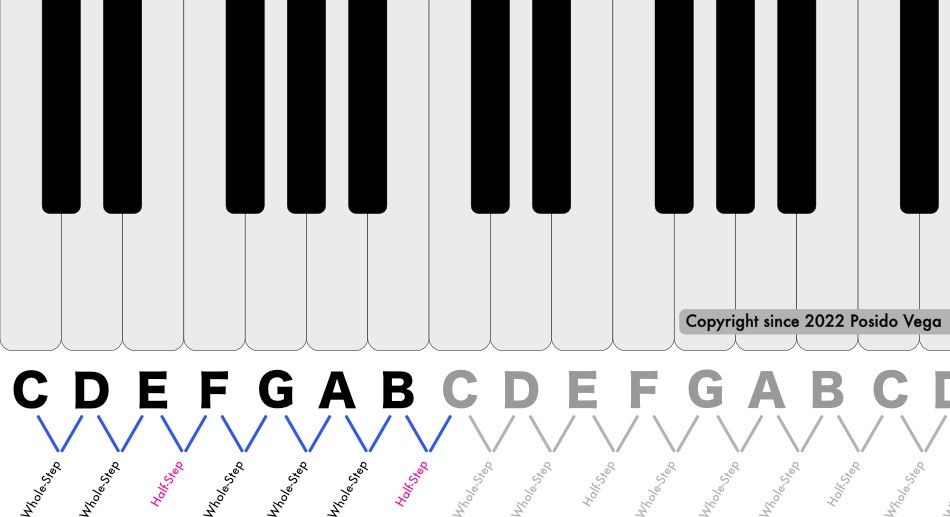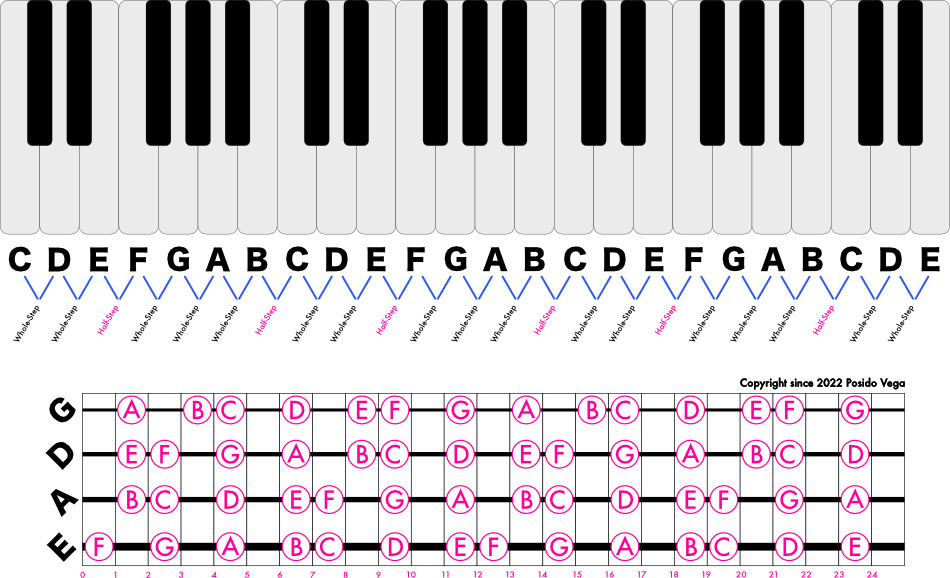Many bass players, even those with years of experience, find themselves unsure about the notes across their bass guitar neck. If you’re in this boat, you’re not alone. But knowing your Bass Guitar Neck Notes is crucial for unlocking your full potential as a bassist.
Learning the notes on your bass guitar neck doesn’t have to be a daunting task. The fretboard is logically organized, and once you grasp this underlying structure, everything will start to click.
In this guide, we’ll explore: A proven, step-by-step method to learn your bass guitar neck notes in a systematic and efficient way (including video explanations).
Let’s dive in and get you acquainted with your fretboard!
Your 4-Step System to Learn Bass Guitar Neck Notes
This approach breaks down learning the fretboard into manageable steps, focusing on understanding the logic rather than rote memorization.
Here’s a summary of the 4 steps:
We’ll explore each of these steps in detail, complete with diagrams and a video to guide you through the process.
Consider bookmarking this page for easy access, especially if you’re new to bass or struggling to memorize the fretboard.
Quick Start Video Guide
For those who prefer a visual overview, here’s a video explaining the entire 4-step method:
 YouTube video
YouTube video
Learn Your Fretboard Bass Guitar Notes Fast! (4 Easy Steps)
Step 1: Understanding the Interval Logic of Musical Notes
In Western music, we primarily use 12 distinct notes. Learning these notes becomes much easier when you understand the logical system behind their names and relationships.
Key Concept: Musical notes follow an alphabetical sequence. If you know your ABCs up to G, you’re already well on your way!
The natural notes are: A, B, C, D, E, F, and G. These are often referred to as natural notes, and they correspond to the white keys on a piano.
This sequence repeats itself continuously: A, B, C, D, E, F, G, A, B, C, D, E, F, G, and so on.
The remaining 5 notes are sharps and flats, which are the black keys on a piano and fall in between the natural notes. These are: A♯/B♭, C♯/D♭, D♯/E♭, F♯/G♭, and G♯/A♭. Notice that these notes have two names – a sharp and a flat name. This is called enharmonic spelling.
While the pitch is the same, the spelling depends on the musical context. For now, focus on recognizing the notes; the nuances of spelling will become clearer as you progress.
Whole Steps and Half Steps Explained
Looking at a piano keyboard, you’ll observe black keys between most white keys, but not everywhere.
Important Tip: There’s no black key between E and F, and no black key between B and C. This principle holds true on the bass fretboard as well!
 Piano keys – Whole-Step and Half-Step Diagram
Piano keys – Whole-Step and Half-Step Diagram
The interval between E and F is always a half step (one fret on the bass). Similarly, the interval between B and C is always a half step (one fret).
All other natural notes are a whole step apart (two frets).
Now, let’s apply this knowledge directly to the bass fretboard. This method is much more intuitive than trying to memorize notes chromatically (fret by fret).
Step 2: Decoding the Bass Guitar Fretboard Logic
Let’s recap what we’ve learned:
- Musical notes are alphabetically ordered.
- E-F and B-C are always a half step apart.
- All other natural notes are a whole step (2 frets) apart.
Now, here’s the crucial fretboard logic to remember:
- Moving one fret on your bass is equivalent to a half step.
- Moving two frets is equivalent to a whole step.
On a standard 4-string bass guitar, the open string notes.) are E, A, D, and G (from thickest to thinnest).
 Bass Guitar Fretboard Notes and Piano Notes Diagram
Bass Guitar Fretboard Notes and Piano Notes Diagram
Let’s begin with the lowest string, the E string. The easiest way to learn the fretboard is to focus on one string at a time.
Remember, E-F and B-C are the only natural note pairs separated by a half step.
Finding Notes on Your E String (The Simple Way)
Starting on the open E string, moving up one fret brings you to F.
By applying the musical alphabet and whole/half step logic, you can easily find all the natural notes on your E string:
- From F, move up two frets to G.
- From G, move up two frets to A.
- From A, move up two frets to B.
- From B, move up one fret to C.
- From C, move up two frets to D.
- From D, move up two frets to E.
- The pattern then repeats.
Let’s apply this to the next string, the A string.
Finding Notes on Your A String (The Simple Way)
The note locations on the A string are:
- From open A, move up two frets to B.
- From B, move up one fret to C.
- From C, move up two frets to D.
- From D, move up two frets to E.
- From E, move up one fret to F.
- From F, move up two frets to G.
- From G, move up two frets to A.
- And again, the pattern repeats.
Let’s continue to the D string.
Finding Notes on Your D String (The Simple Way)
The note locations on the D string are:
- From open D, move up two frets to E.
- From E, move up one fret to F.
- From F, move up two frets to G.
- From G, move up two frets to A.
- From A, move up two frets to B.
- From B, move up one fret to C.
- From C, move up two frets to D.
- The pattern repeats.
One string left! Let’s find the notes on the G string.
Finding Notes on Your G String (The Simple Way)
The note locations on the G string are:
- From open G, move up two frets to A.
- From A, move up two frets to B.
- From B, move up one fret to C.
- From C, move up two frets to D.
- From D, move up two frets to E.
- From E, move up one fret to F.
- From F, move up two frets to G.
- The pattern repeats.
Now, let’s accelerate your learning by exploring octaves!
Step 3: Utilizing Octaves as Fretboard Landmarks
This step is key to quickly navigating your fretboard. Octaves act as reference points. While other intervals like fifths can also be used, octaves are particularly helpful for beginners because they are the same note, just higher or lower in pitch.
A perfect octave represents the same note at double (or half) the frequency.
There are many octaves across your bass fretboard. Learning their positions is a game-changer.
Find and memorize these octave shapes along the neck.
Bass Guitar Fretboard Octaves Diagram
Diagram showing octave patterns on the bass guitar fretboard, illustrating different shapes to easily locate octaves.
Here are some easy-to-remember octave shapes:
- Move two frets higher and two strings up to find an octave higher.
- Move two frets lower and two strings down to find an octave lower.
- Move three frets lower and three strings up to find an octave higher.
- Move three frets higher and three strings down to find an octave lower.
- Move five frets lower and one string up to find an octave higher.
- Move five frets higher and one string down to find an octave lower.
- Move seven frets higher and one string up to find an octave higher.
- Move seven frets lower and one string down to find an octave lower.
Step 4: Practical Application in Musical Contexts
While the first three steps provide the knowledge base, Step 4, applying this logic and using octaves as landmarks, is what will truly solidify your fretboard mastery.
Essential Tip: There’s no shortcut. You need to play your bass and actively apply what you’ve learned.
The more you practice applying this knowledge, the more intuitive the notes will become, and you’ll master the fretboard faster than you might expect.
Try this exercise: Use a simple bass line and a metronome. Play the root note and then immediately find and play the octave of that root in the bass line.
You’ll quickly realize how easy it becomes to locate notes across the fretboard.
(Bonus) Step 5: Verbalize Note Names During Practice
During your practice sessions, dedicate a few minutes to consciously saying the name of each note aloud as you play it.
Practice slowly and deliberately.
Focus on accuracy over speed.
This technique is incredibly effective for quickly learning the bass notes. A method I personally used was to say the note name, locate it on the fretboard, and then play it. When learning to read standard music notation, verbalizing note names reinforced their positions on the fretboard.
Incorporate this into band practice, jams, and even live performances. This way, you’re learning while actively playing music.
This forces you to think on your feet and builds confidence, especially when starting out.
Your Turn to Play
Understanding the logic and octave patterns is valuable knowledge, but its real power comes when you put it into practice.
Knowing your bass guitar neck notes is fundamental for improvisation, reading music, and playing along to chord charts accurately and in time.
So, start applying these steps, and you’ll see significant progress in weeks.
For more resources and lessons like this, explore My Sandbox.
Frequently Asked Questions
What are the Notes on a Bass Guitar? (Standard Tuning)
On a standard 4-string bass, the open string notes are E, A, D, and G.
For a 5-string bass, the notes are B, E, A, D, and G.
A 6-string bass is tuned to B, E, A, D, G, and C.
Standard bass tuning is in fourths. Understanding fourth intervals, similar to octaves, can be another useful pattern for learning notes across strings.
What’s the Most Effective Way to Memorize Bass Guitar Notes?
A common question is, “How do I memorize the notes on the bass?”
My answer is always, “Don’t focus on rote memorization.”
It’s far more effective to understand the underlying logic of note names and the fretboard layout. Once you grasp these principles, the positions of notes on the neck become intuitive and logical.
Develop good habits like recognizing patterns, identifying shapes, and naming notes aloud. Trust the process.
Natural memorization arises from finding connections and meaning in the information you’re learning. Recognizing patterns and shapes is a powerful way to create these mental connections.
How Can I Quickly Find Notes on the Bass Guitar?
To quickly locate notes on the bass guitar, focus on understanding the fretboard. A 4-string bass in standard tuning has strings E, A, D, and G. The fretboard mirrors the logical layout of a piano. All natural notes are a whole step apart, except for E and F (half step) and B and C (half step). All other natural note intervals are whole steps.

